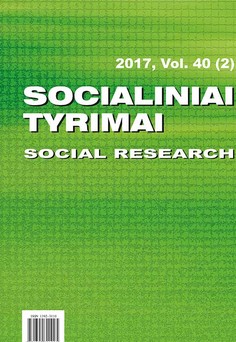Lietuvos savivaldybių skolinimosi situacijos analizė
The Situation Analysis of Municipal Borrowing
Author(s): Dalia Rudytė, Solveiga Skunčikienė, Dovilė Ruplienė, Lina Garšvienė, Roberta BajorūnienėSubject(s): Public Administration, Economic policy, Comparative politics, EU-Approach / EU-Accession / EU-Development, Fiscal Politics / Budgeting
Published by: Vilniaus Universiteto Leidykla
Keywords: municipal budget; municipal debt; municipal debt need; municipal borrowing potential;
Summary/Abstract: Growing municipal borrowing is not surprising today because not only municipalities but also the state itself borrows actively. We live in a period when the funds of EU are actively being absorbed, and according to regulations, in order to use these funds, it is necessary, albeit a small part, to add own funds. The borrowing requirement which exists at all levels of government is aggregated, and borrowed funds represent the total public debt. When the need arises, municipalities, like the state, can borrow financial resources, but their borrowing is more regulated than the state. The research problem. The annual public resources generated by municipalities represent only a small fraction of public finance flows circulating in state jurisdiction. The financial situation of municipalities is complicated due to the fact that insufficient funds are allocated from the state budget to ensure the performance of state delegated functions. This article looks at the answers to questions of what are the reasons for municipal borrowing and what are the opportunities of growing borrowing to continue borrowing? The object of the research is municipal debt. The purpose of the research is to analyze municipal debt and borrowing as a phenomenon and to reveal the borrowing situation of Lithuanian municipalities. The statistical data of the Department of Statistics to the Government of the Republic of Lithuania, the Ministry of Finance of the Republic of Lithuania and the Association of Lithuanian Municipalities were used for the analysis. For the analysis of the municipal debt situation the budget income and expenditures of all sixty municipalities and municipal net annual borrowing were analyzed. Research period is 2005–2014. This choice of the research period allows to partially eliminate the influence of economic cyclicality, because this period covered rapid economic growth after Lithuania’s accession to the European Union, a period of economic recession since 2008, and the last economic recovery period. Based on the analysis, municipal borrowing in Lithuania and other countries is strictly regulated with established borrowing limits and borrowing objectives, usually borrowing is in the domestic banking market for a long or short period. The reasons for borrowing are varied, but usually they are aimed at attracting additional investment by contributing to the borrowed funds of the municipality. In most cases, municipalities pay off in the implementation of EU structural funds projects, to which they themselves have to contribute. In 2013–2014, the debt for these projects amounted to about 50% of all municipal debts. Due to EU projects, debt grows in all municipalities. Another reason for borrowing is related to the increasing trend of municipal functions in Lithuania, although self-generated municipal income is decreasing. All this also becomes the reason for borrowing. The total debt of all municipalities in Lithuania, per capita, is increasing every year. During the analyzed period, this debt increased by 4.68 times. However, the municipal debt of Lithuania compared with the debt of municipalities of other EU countries shows that this debt is not high and has a potential for future growth. However, since 2014, the debt of Lithuanian municipalities, albeit insignificant, has been decreasing. Very similar debt is also in Estonia, slightly more in Latvia. The most indebted are the municipalities of France, Germany, Italy, and the United Kingdom. The growing responsibilities of municipalities in Lithuania reflect the development of active regions, which invest heavily in infrastructure, community projects and economics, and therefore EU funds provide funding to municipalities in implementing targeted projects. On the basis of rules in Lithuania, in order to receive EU funds, the municipality must itself contribute with its own funds to the ongoing project. In such cases, the state gives the municipalities the right to increase their obligations. During the analyzed period, in comparison with the Lithuanian metropolitan municipalities, Vilnius city, Klaipeda City, and Kaunas City municipalities borrowed the most. It is considered that the high level of indebtedness of major cities of Lithuania is determined by both the desire to create an attractive and balanced environment for a large flow of people and business entities to live and work as well as implementation of a large and strategic state infrastructure projects. Borrowing is an inevitable macroeconomic process that can spur economic growth. If borrowed funds are diverted to productive investments and the level of debt does not endanger economic stability, municipalities could increase their debts, of course guaranteeing the repayment of debt in a timely manner. The problem arises when borrowed funds are used only for consumption or short-term projects, thus these funds do not generate the necessary income in order to timely repay the debt, therefore the situation becomes difficult without the additional state financial support.
Journal: Socialiniai tyrimai
- Issue Year: 40/2017
- Issue No: 2
- Page Range: 44-54
- Page Count: 11
- Language: Lithuanian

